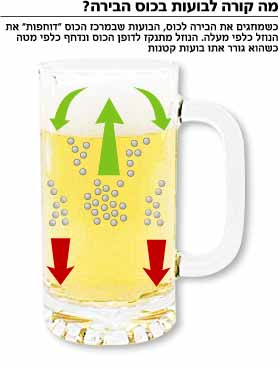
Direct link to this page: https://www.hayadan.org.il/bearbubbles.html
Generations of drinkers reported the phenomenon and no one believed them. They swore that when the bartender pours beer into their glass, the bubbles - which according to the known laws of nature are supposed to float up - actually "sink" down. Bartenders and scientists dismissed the beer drinkers' reports, thinking they must be drugged. Two scientists, Prof. Richard Zer, a chemist from the Faculty of Life Sciences from the American Stanford University and Dr. Andrew Alexander from the Scottish University of Edinburgh, decided to find out the matter to the end. After weeks of research and filming dozens of beer pours, they stopped: sometimes, the bubbles do fall down.
"The bubbles are lighter than the beer, so they should float upwards", Prof. Zer presented the problem. "It was a big surprise to receive reports, according to which, when you pour Guinness type beer (a black beer made in Ireland) into a glass, the bubbles that are created during the pouring actually go to the bottom of the glass. When we first heard about it we couldn't believe it; We were sure that those who reported the phenomenon drank too much Guinness."
When the two began to investigate, it became clear to them that the issue had already been examined four years ago. A team of Australian scientists worked on building computer simulation software, which proved that the downward movement of the bubbles is theoretically possible. The Australians based the model on Guinness, which beyond the intoxicating liquid contains a combination of two gases: nitrogen and carbon dioxide. Zer says that he and his colleague questioned the computer model, and decided to conduct a real field study.
"We started with many experiments, which were very fun but from a scientific point of view did not provide unequivocal results," Zar said. Then came the breakthrough. Dr. Alexander obtained a camera that takes 750 pictures per second. "With the help of the camera, we were able to document the process from start to finish. We obtained beautiful video clips", notes Zer.
Now the two scientists claim that by analyzing the images they were able to verify the Australian findings. "The reason for this is quite simple," says Zer in a filmed interview, which Stanford University uploaded to its website. "This is based on the idea - 'what goes up, must also come down.' In this case, what rises to the top are the beer bubbles." According to him, most of the beer bubbles rise in the center of the glass, because in this area they do not rub against the side of the glass which slows down their movement. "When they go up, they pull with them the liquid that needs to be poured somewhere," Alexander explained.
According to him, the beer spills over the side of the glass and when it "falls" down, it attracts bubbles, especially the small ones. "The small bubbles are pushed by the drink that rose from the bottom of the glass to the surface and is now looking for a way to go down," he said. Zer added that after a while the process stopped "but when it happens, it is very dramatic". According to Alexander, the two were able to prove that a similar process also occurs in other beers that do not contain nitrogen, such as Guinness. "Today we know that the same process can be carried out with any type of liquid, even with water into which we insert an effervescent tablet that produces bubbles."
"We owe the sensational discovery to those people who pay attention to the world around them; In this sense, anyone who enters a pub and orders a glass of Guinness beer is a scientist," said Alexander.
Yuval Dror, Haaretz
Strange and interesting
https://www.hayadan.org.il/BuildaGate4/general2/data_card.php?Cat=~~~793719046~~~95&SiteName=hayadan
